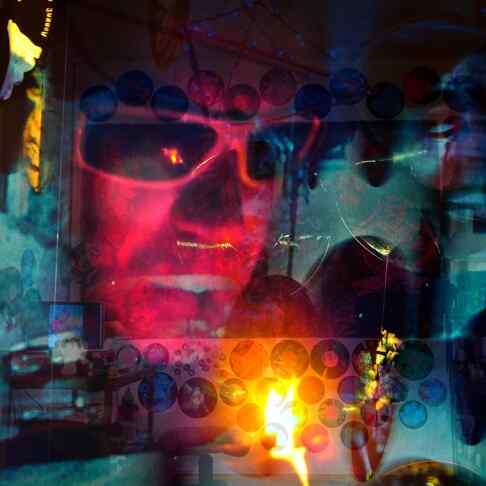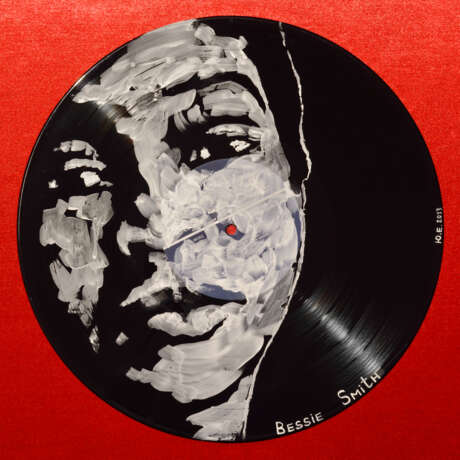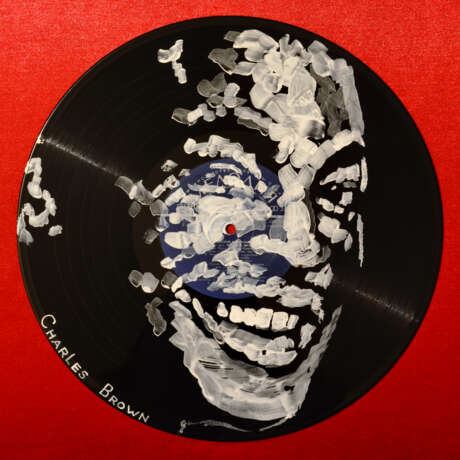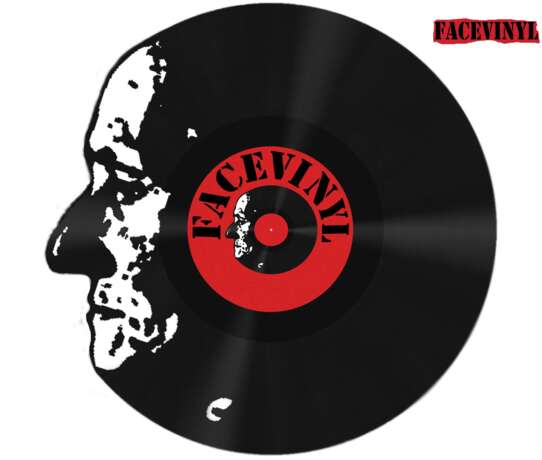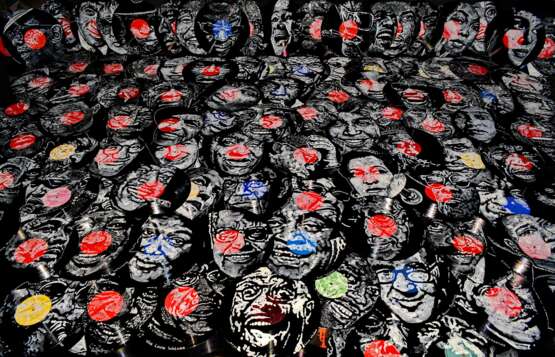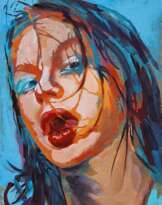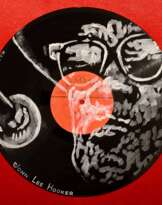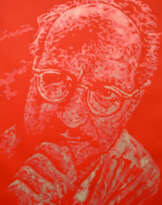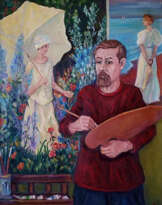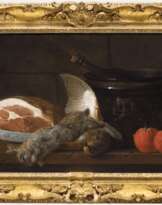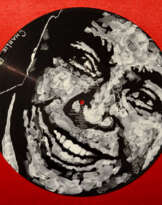Bessie Smith & Charles Brown Acrylic painting Modern art 2013
Yury Ermolenko, ''Bessie Smith'' - Facevinyl - THE BIG COLLECTION - №22, side I, 2013, acrylic on vinyl. The History of Jazz and Blues.
Yury Ermolenko, ''Charles Brown'' - Facevinyl - THE BIG COLLECTION - №22, side II, 2013, acrylic on vinyl. The History of Jazz and Blues.
Bessie Smith (April 15, 1894 – September 26, 1937) was an American blues singer. Nicknamed the Empress of the Blues, she was the most popular female blues singer of the 1920s and 1930s. She is often regarded as one of the greatest singers of her era and was a major influence on other jazz singers.
Smith began forming her own act around 1913, at Atlanta's "81" Theater. By 1920, she had established a reputation in the South and along the East Coast.
Bessie Smith was signed to Columbia Records in 1923 by Frank Walker, a talent agent who had seen her perform years earlier. Her first session for Columbia was on February 15, 1923. For most of 1923, her records were issued on Columbia's regular A-series. When the company established a "race records" series, Smith's "Cemetery Blues" (September 26, 1923) was the first issued.
Both sides of her first record, "Downhearted Blues" backed with "Gulf Coast Blues", were hits (an earlier recording of "Downhearted Blues" by its co-writer Alberta Hunter had previously been released by Paramount Records). Smith became a headliner on the T.O.B.A. circuit and rose to become its top attraction in the 1920s. Working a heavy theater schedule during the winter and performing in tent shows the rest of the year (eventually traveling in her own railroad car), Smith became the highest-paid black entertainer of her day. Columbia nicknamed her "Queen of the Blues," but the press soon upgraded her title to "Empress of the Blues". Smith’s music stressed independence, fearlessness, and sexual freedom, implicitly arguing that working-class women did not have to alter their behavior in order to be worthy of respect.
Smith had a strong contralto voice, which recorded well from her first session, which was conducted when recordings were made acoustically. With the advent of electrical recording (her first electrical recording was "Cake Walking Babies [From Home]", recorded on May 5, 1925), the sheer power of her voice was even more evident. She was also able to benefit from the new technology of radio broadcasting, even on stations in the segregated South. For example, after giving a concert for a white-only audience at a theater in Memphis, Tennessee, in October 1923, she then performed a late-night concert on station WMC, which was well received by the radio audience.
She made 160 recordings for Columbia, often accompanied by the finest musicians of the day, notably Louis Armstrong, Coleman Hawkins, Fletcher Henderson, James P. Johnson, Joe Smith, and Charlie Green.
Smith advocated for a wider vision of African-American womanhood beyond domesticity, piety, and conformity; she sought empowerment and happiness through independence, sassiness, and sexual freedom.
Smith's career was cut short by the Great Depression, which nearly put the recording industry out of business, and the advent of "talkies", which spelled the end of vaudeville. She never stopped performing, however. The days of elaborate vaudeville shows were over, but Smith continued touring and occasionally sang in clubs. In 1929, she appeared in a Broadway musical, Pansy.
In 1929, Smith made her only film appearance, starring in a two-reeler, St. Louis Blues, based on W. C. Handy's song of the same name. In the film, directed by Dudley Murphy and shot in Astoria, Queens, she sings the title song accompanied by members of Fletcher Henderson's orchestra, the Hall Johnson Choir, the pianist James P. Johnson and a string section—a musical environment radically different from that of any of her recordings.
Tony Russell "Charles" Brown (September 13, 1922 – January 21, 1999) was an American blues singer and pianist whose soft-toned, slow-paced blues-club style influenced blues performance in the 1940s and 1950s. He had several hit recordings, including "Driftin' Blues" and "Merry Christmas Baby".
In Los Angeles, an influx of African Americans from the South during World War II created an integrated nightclub scene in which black performers tended to minimize the rougher blues elements of their style. The blues-club style of a light rhythm bass and right-hand tinkling of the piano and smooth vocals became popular, epitomized by the jazz piano of Nat King Cole. When Cole left Los Angeles to perform nationally, his place was taken by Johnny Moore's Three Blazers, featuring Brown's gentle piano and vocals.
The Three Blazers signed with Exclusive Records, and their 1945 recording of "Drifting Blues", with Brown on piano and vocals, stayed on the U.S. Billboard R&B chart for six months, putting Brown at the forefront of a musical evolution that changed American musical performance. Brown's style dominated the influential Southern California club scene on Central Avenue, in Los Angeles, during that period. He influenced such performers as Floyd Dixon, Cecil Gant, Ivory Joe Hunter, Percy Mayfield, Johnny Ace and Ray Charles.
Brown left the Three Blazers in 1948 and formed his own trio with Eddie Williams (bass) and Charles Norris (guitar). He signed with Aladdin Records and had immediate success with "Get Yourself Another Fool" and then had one of his biggest hits, "Trouble Blues", in 1949, which stayed at number one on the Billboard R&B chart for 15 weeks in the summer of that year. He followed with "In the Evening When the Sun Goes Down", "Homesick Blues", and "My Baby's Gone", before having another R&B chart-topping hit with "Black Night", which stayed at number one for 14 weeks from March to June 1951. His final hit for several years was "Hard Times" in 1952.
His "Please Come Home for Christmas", a hit for King Records in 1960, remained seasonally popular. "Please Come Home for Christmas" had sold over one million copies by 1968 and was awarded a gold disc in that year. In the 1960s Brown recorded two albums for Mainstream Records.
In the 1980s Brown made a series of appearances at the New York City nightclub Tramps. As a result of these appearances he signed a recording contract with Blue Side Records and recorded One More for the Road in three days. Blue Side Records closed soon after, but distribution of its records was picked up by Alligator Records. Soon after the success of One More for the Road, Bonnie Raitt helped usher in a comeback tour for Brown.
He began a recording and performing career again, under the musical direction of the guitarist Danny Caron, to greater success than he had achieved since the 1950s. Other members of Charles's touring ensemble included Clifford Solomon on tenor saxophone, Ruth Davies on bass and Gaylord Birch on drums. Several records received Grammy Award nominations. In the 1980s Brown toured widely as the opening act for Raitt.
Brown was inducted into the Blues Hall of Fame in 1996 and was inducted into the Rock and Roll Hall of Fame in 1999. He was a recipient of a 1997 National Heritage Fellowship awarded by the National Endowment for the Arts, which is the highest honor in the folk and traditional arts in the United States.
Yury Ermolenko, ''Charles Brown'' - Facevinyl - THE BIG COLLECTION - №22, side II, 2013, acrylic on vinyl. The History of Jazz and Blues.
Bessie Smith (April 15, 1894 – September 26, 1937) was an American blues singer. Nicknamed the Empress of the Blues, she was the most popular female blues singer of the 1920s and 1930s. She is often regarded as one of the greatest singers of her era and was a major influence on other jazz singers.
Smith began forming her own act around 1913, at Atlanta's "81" Theater. By 1920, she had established a reputation in the South and along the East Coast.
Bessie Smith was signed to Columbia Records in 1923 by Frank Walker, a talent agent who had seen her perform years earlier. Her first session for Columbia was on February 15, 1923. For most of 1923, her records were issued on Columbia's regular A-series. When the company established a "race records" series, Smith's "Cemetery Blues" (September 26, 1923) was the first issued.
Both sides of her first record, "Downhearted Blues" backed with "Gulf Coast Blues", were hits (an earlier recording of "Downhearted Blues" by its co-writer Alberta Hunter had previously been released by Paramount Records). Smith became a headliner on the T.O.B.A. circuit and rose to become its top attraction in the 1920s. Working a heavy theater schedule during the winter and performing in tent shows the rest of the year (eventually traveling in her own railroad car), Smith became the highest-paid black entertainer of her day. Columbia nicknamed her "Queen of the Blues," but the press soon upgraded her title to "Empress of the Blues". Smith’s music stressed independence, fearlessness, and sexual freedom, implicitly arguing that working-class women did not have to alter their behavior in order to be worthy of respect.
Smith had a strong contralto voice, which recorded well from her first session, which was conducted when recordings were made acoustically. With the advent of electrical recording (her first electrical recording was "Cake Walking Babies [From Home]", recorded on May 5, 1925), the sheer power of her voice was even more evident. She was also able to benefit from the new technology of radio broadcasting, even on stations in the segregated South. For example, after giving a concert for a white-only audience at a theater in Memphis, Tennessee, in October 1923, she then performed a late-night concert on station WMC, which was well received by the radio audience.
She made 160 recordings for Columbia, often accompanied by the finest musicians of the day, notably Louis Armstrong, Coleman Hawkins, Fletcher Henderson, James P. Johnson, Joe Smith, and Charlie Green.
Smith advocated for a wider vision of African-American womanhood beyond domesticity, piety, and conformity; she sought empowerment and happiness through independence, sassiness, and sexual freedom.
Smith's career was cut short by the Great Depression, which nearly put the recording industry out of business, and the advent of "talkies", which spelled the end of vaudeville. She never stopped performing, however. The days of elaborate vaudeville shows were over, but Smith continued touring and occasionally sang in clubs. In 1929, she appeared in a Broadway musical, Pansy.
In 1929, Smith made her only film appearance, starring in a two-reeler, St. Louis Blues, based on W. C. Handy's song of the same name. In the film, directed by Dudley Murphy and shot in Astoria, Queens, she sings the title song accompanied by members of Fletcher Henderson's orchestra, the Hall Johnson Choir, the pianist James P. Johnson and a string section—a musical environment radically different from that of any of her recordings.
Tony Russell "Charles" Brown (September 13, 1922 – January 21, 1999) was an American blues singer and pianist whose soft-toned, slow-paced blues-club style influenced blues performance in the 1940s and 1950s. He had several hit recordings, including "Driftin' Blues" and "Merry Christmas Baby".
In Los Angeles, an influx of African Americans from the South during World War II created an integrated nightclub scene in which black performers tended to minimize the rougher blues elements of their style. The blues-club style of a light rhythm bass and right-hand tinkling of the piano and smooth vocals became popular, epitomized by the jazz piano of Nat King Cole. When Cole left Los Angeles to perform nationally, his place was taken by Johnny Moore's Three Blazers, featuring Brown's gentle piano and vocals.
The Three Blazers signed with Exclusive Records, and their 1945 recording of "Drifting Blues", with Brown on piano and vocals, stayed on the U.S. Billboard R&B chart for six months, putting Brown at the forefront of a musical evolution that changed American musical performance. Brown's style dominated the influential Southern California club scene on Central Avenue, in Los Angeles, during that period. He influenced such performers as Floyd Dixon, Cecil Gant, Ivory Joe Hunter, Percy Mayfield, Johnny Ace and Ray Charles.
Brown left the Three Blazers in 1948 and formed his own trio with Eddie Williams (bass) and Charles Norris (guitar). He signed with Aladdin Records and had immediate success with "Get Yourself Another Fool" and then had one of his biggest hits, "Trouble Blues", in 1949, which stayed at number one on the Billboard R&B chart for 15 weeks in the summer of that year. He followed with "In the Evening When the Sun Goes Down", "Homesick Blues", and "My Baby's Gone", before having another R&B chart-topping hit with "Black Night", which stayed at number one for 14 weeks from March to June 1951. His final hit for several years was "Hard Times" in 1952.
His "Please Come Home for Christmas", a hit for King Records in 1960, remained seasonally popular. "Please Come Home for Christmas" had sold over one million copies by 1968 and was awarded a gold disc in that year. In the 1960s Brown recorded two albums for Mainstream Records.
In the 1980s Brown made a series of appearances at the New York City nightclub Tramps. As a result of these appearances he signed a recording contract with Blue Side Records and recorded One More for the Road in three days. Blue Side Records closed soon after, but distribution of its records was picked up by Alligator Records. Soon after the success of One More for the Road, Bonnie Raitt helped usher in a comeback tour for Brown.
He began a recording and performing career again, under the musical direction of the guitarist Danny Caron, to greater success than he had achieved since the 1950s. Other members of Charles's touring ensemble included Clifford Solomon on tenor saxophone, Ruth Davies on bass and Gaylord Birch on drums. Several records received Grammy Award nominations. In the 1980s Brown toured widely as the opening act for Raitt.
Brown was inducted into the Blues Hall of Fame in 1996 and was inducted into the Rock and Roll Hall of Fame in 1999. He was a recipient of a 1997 National Heritage Fellowship awarded by the National Endowment for the Arts, which is the highest honor in the folk and traditional arts in the United States.
| ID: | 17384 |
|---|---|
| Artist: | Yurii Yermolenko (b. 1973) |
| Originality: | Original |
| Condition: | new |
| Year of manufacture: | 2013 |
| Applied technique: | See description, Acrylic painting |
| Size: | 30 x 30 x 0.2 cm |
| Framing: | Unframed |
| Art style: | Modern art |
Information about the artist
